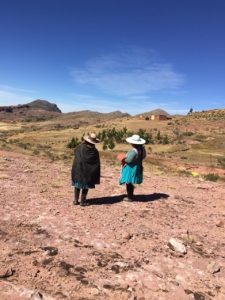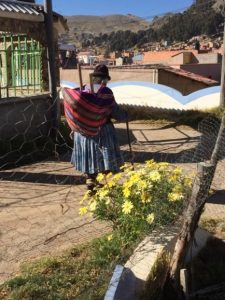Rural women’s contribution to food and nutrition security in Bolivia

28.03.2021
Written by Léa Berthelin
Translated by Inji Achour
Ensuring the food and nutrition security of a country is an essential daily issue that concerns the public authority in place, but also and above all, its inhabitants. For this reason, to better understand the principles and the functioning of food and nutrition security in Bolivia, it’s important to turn to rural women, discreete but crucial contributors to its maintenance. Without them, it’s safe to bet that the country’s food security, which is already fragile, would not be nearly as apprehended or secured. How can we explain this phenomenon that is particular to Bolivia and under which form(s) do rural women take part in the country’s food and nutrition security? After an analysis of the link between rural women, agriculture and food security, we will touch on the constraints that they face then the opportunities that exist nowadays for Bolivian rural women
Bolivia, food security and rural women: the context
The Plurinational State of Bolivia, more commonly known as Bolivia as Bolivia, is a landlocked country with a territory of just over one million square kilometers and a population of over eleven million inhabitants. It’s characterized by a rich cultural and climatic diversity and is distinguished in particular by the establishment of numerous social policies over the last two decades as well as a growing consideration of the indigenous communities that the country is composed of.
The Bolivian constitution of 2009, resulting from a consultation between Constitutive Assemblies composed of farmers and indigenous movements, illustrates these communitarian advances. It is thus one of the only countries in the world to have enshrined the principle of food sovereignty based on a rural development model which relies on family and local agriculture and enshrines food as a fundamental right by placing the human at the center of its development. From this constitutional principle stems that of the food and nutrition security[1]Since 1996, the World Committee on food security has adopted the following official definition: “Food security exists when all people, at all times, have physical and economic access to sufficient, … Continue reading, which is the object of our study and is also central in Bolivia. This State protection concerns mainly small farmers in rural areas who cover close to 85% of the nutritional needs of the Bolivian population[2]FAO, The economic lives of smallholder farmers-An analysis based on household data from 9 countries, 2015, 39p.. Among them are 1,670,458 rural women, contributing daily to markets’ supply and the food security of the population[3]Naciones Unidas Bolivia, ONU Mujeres y FAO en el Día internaciónal de la mujer rural reconocen su aporte al desarrollo sostenible de la seguridad alimentaria, 15-10-2018..
Whereas in the rest of Latin America, active rural women’s share in the agricultural sector tends to progressively decrease, the opposite effect can be observed in Bolivia. According to the last population census in 2012[4]Instituto Nacional de Estadística (INE), Censo Nacional de Población y Vivienda, 2012., they represented 41.8% in 2010 versus 33% in 1980, despite a very random and uncertain remuneration.
Rural women’s contribution to food security, from production to consumption
In Bolivia, one third of the population lives in rural areas[5]INE, 2018.. In spite of an important rural exodus, as commonly observed in all developing countries, the agriculture sector constitutes the first source of employment for rural Bolivians with an impressive feminisation rate: it can reach 48% versus 52% for men as seen in the Altiplano department (La Paz, Oruro and Potosi). It is then necessary to analyze the scale of agricultural activities of rural women, which extends from production to consumption, thus relatively ensuring food security in the country.
The first observation that can be made is that small-scale agriculture, usually family-based, employs more women, similarly to dairy activity in Altiplano, than in the case of extensive agricultural practices that require more significant investments in the suitable equipment as shown in tropical regions (Santa Cruz, Beni, Pando)[6]ONU Mujeres, Enfoque territorial para el empoderamiento de las mujeres rurales, 2018, 140p.. Thus, most of the time, rural women are engaged in both farming and animal breeding. The cultivation of potatoes, especially in the regions of the Altiplano, is the most popular, followed by that of cereals (barley, wheat, oats, quinoa). The breeding consists of chickens, sheep, pigs, cows and sometimes donkeys and llamas. The size of their herds is however quite limited; larger herds often remain the prerogative of men. The maintenance of crops and livestock involves many manual activities throughout the year (seeding, plowing, irrigation, harvesting, animal care, etc.).
The processing of crop and livestock products also represents a big part of women’s agricultural work. When it comes to crops, for example, potatoes can be made into chuños (dehydrated potatoes) and corn into chicha (corn-based alcohol). The use of livestock products ranges from making cheese to using wool from sheep and llamas[7]Cécile COLLINGE, La contribution des terres des femmes à la souveraineté alimentaire en Bolivie., 2015, 244p..
The majority of the production is intended for self-consumption: women are almost always in charge of preparing meals in their homes. The rest of the uneaten food is sold in markets, in nearby towns or exchanged for other types of food. This time as well, this task falls onto women. Therefore, it seems that rural women are also in charge of supplying food to the urban population; with buying food from markets being the most common, simple and economical means of access to food for many Bolivians. This access to markets was however disturbed during the Covid-19 pandemic, so an extension of circulation permit was then put in place for local organizations and cooperatives in order to ensure the supply of food goods in the markets and thus guarantee a certain income for rural women[8]ONU Mujeres, Análisis del impacto COVID19 sobre las mujeres trabajadoras en Bolivia, 2020, 20p..
Other than a considerable quantitative presence in the agricultural sector, the qualitative contribution in terms of food and food security embodied by rural women and more particularly, indigenous women, should be mentioned. Bolivia attaches substantial importance to indigenous culture, a major and historical component of the country’s history. The election of Eve Morales, of Aymaran origin, in 2006 as well as the inscription of 36 of the country’s indigenous languages as “official” in the Constitution, reflects the increasing consideration of Bolivia towards its cultural diversity. For food security, this translates into several principles and elements, conveyed by rural women. The esteem for Pachamama (Mother Earth), resulting from the pre-Inca culture, is still very present among the Aymara and Quetchua peopl
es, leading to respect for the earth, the natural elements and the foods which come from it, in particular by rural women. In addition, because of the importance given to family, peasant and indigenous farming, translated into the adoption of numerous laws on the matter[9]Ley 338 “ley de organizaciones económicas campesinas, indígena originarias – oecas y de organizaciones económicas comunitarias – oecom para la integración de la agricultura familiar … Continue reading, it appears that food that is less industrially processed and without chemical inputs is largely favored. In addition, the cultivation and use of medicinal plants is also part of the livelihoods targeted by indigenous rural women and contributes as well to the food security of the country.
The role of rural women in Bolivia in food security is therefore both multiple and omnipresent, while being poorly represented in the country’s data and statistics. Their contribution to food security is consequently underestimated. This statistical invisibility reflects the obstacle to recognizing the contribution of rural women in this matter, which is nevertheless one of the only opportunities available to them.

A contribution limited by many constraints
The predominance of the informal sector in Bolivia[10]According to UN Women (2015), 70% of active women in Bolivia work in the informal sector., particularly in the agricultural sector, partially explains why rural women’s contribution to food security goes largely unnoticed, and this is not without its consequences. Other than the absence of social benefits accorded to a declared job, it also means that remuneration is often absent and uncertain. The fact that women are particularly present in family farming doesn’t necessarily play to their advantage: their contribution to farming passes as unpaid domestic help. In addition, this substantial time spent working in the fields (the productive sphere) is added to the time dedicated to the family and the home (the reproductive sphere) and to the time spent in the community (the collective sphere), both time-consuming, while necessary, but still unpaid. Aware of this problem, Bolivia is also considering launching a survey in order to better transcribe the temporal realities of women, particularly in rural areas[11]“INE urge realizar encuesta de “uso del tiempo” en el país”, Bolivia en tus Manos, 5-09-2016, … Continue reading.
Other obstacles limiting the productive potential of rural women include access to land, which is largely male dominated. In 2017, the Instituto Nacional de Reforma Agraria (National Institute for Agricultural Reform) reported that 46% of landowners are women, without specifying if they are its sole owners, and this is often not the case[12]INRA, 2017..It is clear that the situation is improving due to certain government measures in favor of rural women, especially indigenous women[13]One of the final provisions of the law (number 8) concerns a guarantee and priority for women in the processes of sanitation and access to land. Ley 3545 de Recondución comunitaria de la Reforma … Continue reading, but there is still a long way to go in this matter. Access to credits, resources and productive services or even equipment adapted to their agricultural practices is a challenge that once again affects rural women in the first place.
Harvesting and marketing food is complicated by the travel involved. Rural women often have to use minibuses, which are unsafe or even dangerous, or walk to the farmlands or nearby towns to sell their produce in the markets. Very few own their own vehicles. Because of the climatic conditions and the often damaged roads, the journeys can take hours and can incur certain costs that can sometimes be high in comparison to women farmers’ income[14]Cécile COLLINGE, La contribution des terres des femmes à la souveraineté alimentaire en Bolivie., 2015, 244p..Bolivia is indeed one of the countries most affected by climate change, directly affecting the agricultural sector and thus the working conditions of women farmers. We remember for example the climatic phenomenon El Niño of 2015 which caused alternating droughts and floods, damaging a large part of the crops and damaging many heads of livestock. Food security is thus regularly put to the test and rural women, accordingly, play a major role in adapting to climate change, by diversifying their seeds or by training themselves on the use of organic fertilizers[15]Sanne Derks, “Más cerca del sol: mujeres bolivianas fuertes se adaptaban al cambio climático”, DW, 24-04-2018..
The Bolivian agricultural model, an opportunity for rural women and for the country’s food security
These few obstacles that have been mentioned ultimately allow us to better understand the resilience capacity of rural Bolivian women. Aware that a part of the country’s food security depends on them, Bolivia has thus put in place a legal framework that is particularly encouraging and protective of rural women. Unlike many countries that rely on tertiarization, rural development and its actors are among the country’s priorities. In the last National Development Plan (2016-2020), three of the thirteen pillars refer to rural women, with particular attention to indigenous women[16]ONU Mujeres, Enfoque territorial para el empoderamiento de las mujeres rurales, 2018, 140p.. In addition, Law No. 144 of 2011[17]Ley 144 de la revolución comunitaria agropecuaria, 26-06-2011. is fundamental with regard to the food security of Bolivians, since it establishes a principle of food sovereignty. Its primary objective is to increase food production from a community economy and small family farming, which is monopolised by rural women, while diversifying the food diet and fighting against poverty in the country, in particular in rural areas[18]Extreme and moderate poverty rates were, respectively, 15.2% and 34.6% in 2018 (versus 38.2% and 60.6% in 2005)- INE, October 2019, … Continue reading.
In addition, and without affecting only women living in rural areas, the political framework rather favorable to the empowerment of women should be mentioned. The country is the second country in the world, after Rwanda, to achieve (almost) democratic parity within representative bodies and many laws, without being totally effective, have been enacted in favor of gender equality.
Another strength of Bolivia, which directly benefits rural women, lies in the strong historical capacity of organizations and cooperatives to make social and political demands heard. The best known in the rural world is the Confédéración Nacional de Mujeres Campesinas Indigenas Oginarias de Bolivia- Bartolina Sisa, created in 1980 and more commonly known as “Bartolinas”[19]https://www.bartolinasisa.org/. Affiliated with the government, its main goal is the full participation of rural women in political, economic and social decision-making in the country; and the supply of materials and equipment for agriculture. Grouping into agricultural cooperatives is also a way for farmers and producers to promote their products more easily but also to avoid intermediate costs and to access markets mor
e easily. Among the members of these cooperatives are women who can thus obtain a fairer salary and access to finance as an association, allowing subsidized access to certain productive resources[20]FAO, « La dolce nueva industria de Bolivia », http://www.fao.org/fao-stories/article/es/c/1253476/.
Bolivia has before it several opportunities which would make it possible to best transcribe the agricultural potential of the country, embodied by rural women. The development of sustainable peasant agriculture free from the inherent systematic indutrialization of globalization is a model which is increasingly attractive, and represents a real boon.
Producing and even exporting agriculture without chemical inputs or industrialized seeds is a strength which should be exploited by small family farming in the country, even if it is weakened by the Covid-19 pandemic[21]Sabrina Serra et propos de Maria Lourdes Varga (AOPEB), « La Bolivie en mode régression OGM », SOS Faim, 28-06-2020, https://www.sosfaim.be/la-bolivie-en-mode-regression-ogm/. This local approach to food security, combined with a holistic vision of the environment and the knowledge of rural stakeholders in terms of respect for the environment, is a definite asset for tomorrow’s agriculture. Moving from rudimentary organic farming to a more productive, efficient and profitable model is undoubtedly a niche in which rural women have a major role to play.
Conclusion
The contribution of rural women to food and nutrition security of the country does not need to be further proven. Essential but relatively invisible, they could until recently count on a government that favored small producers, without obtaining full social or financial recognition for their participation. We can only hope that the election of Luis Arce in October 2020 at the head of the country, from the same party as Evo Morales (the Movement towards Socialism), will make it possible to recognize the potential of rural women, be it for national food security or for other equally crucial issues such as the protection of biodiversity.

To cite this article: Léa BERTHELIN, “Rural women’s contribution to food and nutrition security in Bolivia”, 28.02.2021, Institut du Genre en Géopolitique.
References
| ↑1 | Since 1996, the World Committee on food security has adopted the following official definition: “Food security exists when all people, at all times, have physical and economic access to sufficient, safe and nutritious food that meets their dietary needs and food preferences for an active and healthy life”. In 2006, the United Nations Organisation for Food and Agriculture (FAO) added that food security ensures “safe, sufficient and nutritious food”. |
|---|---|
| ↑2 | FAO, The economic lives of smallholder farmers-An analysis based on household data from 9 countries, 2015, 39p. |
| ↑3 | Naciones Unidas Bolivia, ONU Mujeres y FAO en el Día internaciónal de la mujer rural reconocen su aporte al desarrollo sostenible de la seguridad alimentaria, 15-10-2018. |
| ↑4 | Instituto Nacional de Estadística (INE), Censo Nacional de Población y Vivienda, 2012. |
| ↑5 | INE, 2018. |
| ↑6 | ONU Mujeres, Enfoque territorial para el empoderamiento de las mujeres rurales, 2018, 140p. |
| ↑7, ↑14 | Cécile COLLINGE, La contribution des terres des femmes à la souveraineté alimentaire en Bolivie., 2015, 244p. |
| ↑8 | ONU Mujeres, Análisis del impacto COVID19 sobre las mujeres trabajadoras en Bolivia, 2020, 20p. |
| ↑9 | Ley 338 “ley de organizaciones económicas campesinas, indígena originarias – oecas y de organizaciones económicas comunitarias – oecom para la integración de la agricultura familiar sustentable y la soberanía alimentaria”, 26-01-2013. |
| ↑10 | According to UN Women (2015), 70% of active women in Bolivia work in the informal sector. |
| ↑11 | “INE urge realizar encuesta de “uso del tiempo” en el país”, Bolivia en tus Manos, 5-09-2016, https://www.boliviaentusmanos.com/noticias/bolivia/223925/ine-urge-realizar-encuesta-de-uso-del-tiempo-en-el-pais.html |
| ↑12 | INRA, 2017. |
| ↑13 | One of the final provisions of the law (number 8) concerns a guarantee and priority for women in the processes of sanitation and access to land. Ley 3545 de Recondución comunitaria de la Reforma Agraria, 28-11-2006. |
| ↑15 | Sanne Derks, “Más cerca del sol: mujeres bolivianas fuertes se adaptaban al cambio climático”, DW, 24-04-2018. |
| ↑16 | ONU Mujeres, Enfoque territorial para el empoderamiento de las mujeres rurales, 2018, 140p. |
| ↑17 | Ley 144 de la revolución comunitaria agropecuaria, 26-06-2011. |
| ↑18 | Extreme and moderate poverty rates were, respectively, 15.2% and 34.6% in 2018 (versus 38.2% and 60.6% in 2005)- INE, October 2019, https://www.ine.gob.bo/index.php/ine-la-pobreza-en-bolivia-se-ha-reducido/ |
| ↑19 | https://www.bartolinasisa.org/ |
| ↑20 | FAO, « La dolce nueva industria de Bolivia », http://www.fao.org/fao-stories/article/es/c/1253476/ |
| ↑21 | Sabrina Serra et propos de Maria Lourdes Varga (AOPEB), « La Bolivie en mode régression OGM », SOS Faim, 28-06-2020, https://www.sosfaim.be/la-bolivie-en-mode-regression-ogm/ |
